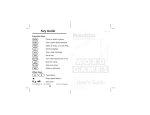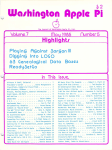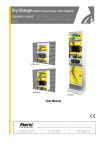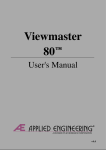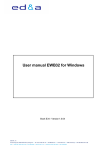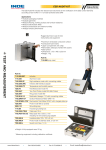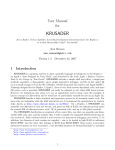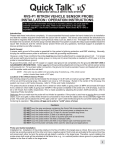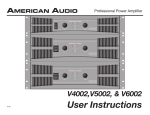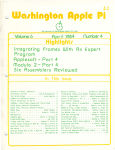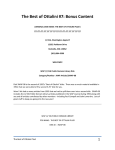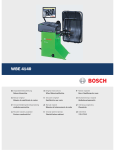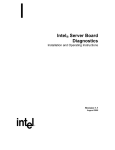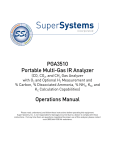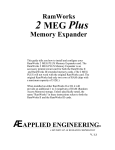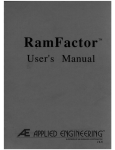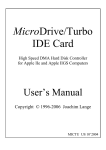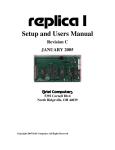Download AE TransWarp - User`s Manual
Transcript
TransWarp _ About This Manual This manual tells you all about installing and using the Applied Engineering TransWarp accelerator card. To get the most out of your new TransWarp, please read this manual carefully. Here’s a summary of what is covered: Introduction: A brief overview of the TransWarp card and its features. Getting Started: What you need to know and do before installing the Trans Warp card in your system. Installation: How to configure and install the TransWarp card in your computer. Using TransWarp: How to activate and control the TransWarp card. This manual was written under the assumption that you are at least familiar with the operation of your computer. For more information on the basic operation and set-up of your system, please refer to the Apple Owner’s Manual for your particular computer. 1 TransWarp Introduction The 6502 microprocessor, or Central Processing Unit (CPU), on an Apple II or //e computer, executes its instructions at a rate of 1 MHz. (One megahertz or one million times a second.) TransWarp puts the Apple’s microprocessor to sleep, while doing some special tricks with its on-board memory, and uses its own high speed microprocessor chip to increase the processing speed to 3.6 MHz! It’s as simple as that. Here’s a list of some of the TransWarp’s features: • 65C02 microprocessor running at a 3.6 MHz clock rate. • 256K of ultra-fast Random Access Memory (RAM). • Acceleration of programs running in both main and auxiliary memory. • Totally transparent operation with all Apple software. • Other than obviously increased speed, operation is also transparent to the user. • Can be installed in an Apple II, II+, IIe, or Enhanced //e. • Compatible with virtually all interface and expansion cards for the Apple. • Three speed settings. 1 MHz, 1.7 MHz, and 3.6 MHz. • Can be controlled from hardware or software. (No preboot disk is needed.) • Low power design for cool operation. • Works with all Apple software, including AppleWorks, SuperCalc 3a, and Applied Engineering’s RamDrive™ programs for DOS 3.3, ProDOS, and Pascal. Expandability. Accelerated 16 Bit option available from Applied Engineering. 2 TransWarp Getting Started Before the TransWarp card is installed in the computer, some of the switches on the TransWarp card may need to be changed to accommodate the timing needs of the other cards installed in your system. TransWarp will work with all standard peripheral cards, such as expanded memory cards, printer and modem interfaces, clock cards, 80 column cards, mouse cards, and disk drive controllers. Some of these cards, though, may not operate as expected at the higher TransWarp speeds. By setting the switches on the TransWarp card, you can tell the TransWarp’s circuitry which cards, in which slots, require the 1 MHz clock rate. This will allow TransWarp to slow down to the Apple’s clock speed momentarily when those cards are accessed by the software. This has a very small effect on the overall TransWarp speed, since these interfaces are accessed for very short periods of the computer’s time. TransWarp must be specially configured to be compatible with memory expansion cards which install in the Apple’s expansion slots (zero through seven) and use the $D000 to $FFFF “language card bank switching technique” to expand the Apple’s memory. For details on the operation of your memory card, refer to its instruction manual. Newer expansion slot memory expansion cards do not use this technique. The procedure for configuring the TransWarp card for expansion slot memory card compatibility is explained in the next section. Due to the number and variety of expansion and interface cards available, it is impassible to list which cards require the 1 MHz clock rate. Without a great deal of technical information, it is also impossible to determine which cards will or won’t work at TransWarp speed. Generally, most floppy disk controllers, serial printer and communications interfaces, and clock cards do require the 1 MHz timing signal. Parallel printer interfaces, hard disk controllers, 80 column cards, and mouse cards usually will operate correctly at full TransWarp speed. The simplest method of determining the timing signal requirement of a card is to try it at TransWarp speed. If it doesn’t work properly, set the appropriate TransWarp switch to slow down for that expansion card slot. The instructions for setting these switches are in the next section. Note: TransWarp was designed to be very power efficient, but like all accelerator cards, it draws a fair amount of power and generates heat. Applied Engineering recommends the use of a cooling fan, such as the Kensington Microware System Saver®, especially when the TransWarp is installed in a lie with the newer style case. These specially designed fans are available from many computer dealers. 3 TransWarp TransWarp Installation Procedure Don’t ZAP your TransWarp! Some components on the TransWarp card are especially static sensitive. Even a small electro-static discharge could damage one of TransWarp’s integrated circuit “chips”. A damaged “chip” might not fail right away, but over time it could become worse, possibly causing one of those nasty “intermittent” problems. Be very careful to handle the TransWarp card ONLY by the edges. Don’t touch the gold edge-connector or any of the components on the TransWarp card other than the switches. Leave the TransWarp card in its anti-static bag until instructed to remove it. Step 1 Leave your computer plugged in, but switch the computer power switch to the OFF position. Remove the top lid of the computer and set it aside. Verify that the red power-on indicator light inside the computer is OFF. (The indicator light is on the main logic board, near the back, just next to the power supply.) Step 2 Discharge any static electricity that may be on your body or clothing by gently touching the metal power supply case. Step 3 Carefully remove the TransWarp card from the anti-static bag. Put the bag flat on a table and set the TransWarp card on the bag. Step 4 Locate the two blocks of switches along the bottom edge of the TransWarp card. Block 1 is the one on the left; block 2 is the one on the right. Use the instructions below, and the chart in Figure 1 to determine the appropriate switch settings for the cards installed in your computer. An example switch configuration for an Apple lle system is shown in Figure 2. To change a switch setting you would “flip” the rocker switch, by pressing in at the top or bottom of the rocker, just like you would a rocker-type household light switch. Pressing in at the bottom of the switch, nearest the word “OPEN”, will OPEN the switch. The switch can be moved to the CLOSED position by pressing in at the top of the rocker, nearest the numbers along the top of the switch block. Never use a pen or pencil to change a switch setting; use a small pointed object, like a wooden toothpick or a bent-out paper clip. See Figure 2. Switches 1 through 7 on each block are numbered and correspond to expansion slot numbers 1 through 7, respectively. On switch block 1, set the appropriate switch to the OPEN position for any slot with an expansion slot memory card using the “language card bank switching technique” described in the previous section. On switch block 2, set the appropriate switch to the OPEN position for any slot with an interface card that requires the 1 MHz timing sign al. A switnch in the CLOSED position selects full TransWarp mode for the corresponding expansion slot. Switches on either bank, corresponding to EMPTY slots, should be switched to the CLOSED position. If you’re not sure if a card requires the 1 MHz rate, try it at TransWarp speed and see if it works. 4 TransWarp _ Switch 8 on both blocks are used in combination to select the default TransWarp speed. These switches should both be in the OPEN position for Full Warp speed. If switch 8 of block 2 is CLOSED, the setting of switch 8 of block 1 is ignored by the TransWarp circuitry. Figure 1 shows the possible combinations and the corresponding TransWarp speeds. Figure 1 TransWarp Switch Blocks BLOCK 1 BLOCK 2 Periferal Card slots Memory Card slots Full TransWarp (3.6 MHz) OPEN....................................................OPEN Half TransWarp (1.7 MHz) CLOSED..................................................OPEN Normal Apple (1 MHz) Normal Apple (1 MHz) OPEN................................................... CLOSED CLOSED................................................ CLOSED Figure 2 Sample Switch Configuration for Apple //e System BLOCK 1 Press switch here to CLOSE BLOCK 2 Press switch here to OPEN System Configuration: TransWarp Switch Settings: Slot 1 Slot 2 Slot 3 Slot 4 Slot 5 Slot 6 Slot 7 Block 2, Switch 1 CLOSED Block 2, Switch 2 OPEN Block 2, Switch 3 CLOSED Block 2, Switch 4 OPEN Block 1, Switch 5 OPEN Block 2, Switch 6 OPEN Block 2, Switch 7 CLOSED Parrallel Printer Interface Card Serial Interface Card TransWarp Clock Card Bank Switch Memory Card Floppy Disk Controller Empty 5 TransWarp Step 5 Plug the TransWarp card in the expansion slot of your choice. If you are installing TransWarp in an Apple //e, slot 3 is recommended. If you have an Apple II or II+, slot 0 is the recommended slot. Since TransWarp also emulates the Apple II language card, which is usually installed in slot 0, the language card is not required when the TransWarp card is active. If you rearrange the cards in your system, be sure to set the TransWarp switches accordingly. Step 6 Replace the top lid of the computer. Installation is complete. Using TransWarp When the computer power is turned on, TransWarp is automatically activated. As the TransWarp firmware is “booted-in” the Apple’s speaker will emit a short (accelerated) “beep”, the “TRANSWARP™” logo will then be displayed on the screen momentarily, followed by another high pitched “beep” from the Apple’s speaker, as the Apple’s firmware is “booted-in.” TransWarp will then accelerate any Apple software run on the system. Except for speed, TransWarp will be completely transparent to the user and the software. The only way to activate TransWarp is by powering-up, or “cold-booting”, the computer. Occasionally, it may be desirable to run some video demonstration programs, games, sound synthesis programs, or other programs at normal Apple speed or at a slower accelerated rate. This can be accomplished through hardware commands, software commands, or a combination of both. Hardware Control To disable the TransWarp completely, immediately after power-up, press the ESCape key while the “TRANSWARP™” logo is still displayed on the screen. The system will continue to boot normally and run at the normal Apple speed of 1 MHz, using the Apple’s processor and memory. IMPORTANT: If your TransWarp card is installed in slot zero of an Apple II, disabling the TransWarp card will also disable the TransWarp’s language card feature. If you encounter this situation, install your language card in slot zero and the TransWarp in another available slot. Remember, the initial speed of the TransWarp is determined by the two number eight switches on the TransWarp card and is indicated to the user by the relative pitch of the speaker’s “beep” at power-up. For example, if switch 8 of block 1 is CLOSED and switch 8 of block 2 is OPEN,the maximum TransWarp speed will be slowed to 1.7 MHz. The “beep” of the speaker will be slightly lower pitched at this rate. 6 TransWarp Software Control Programmers can also control TransWarp from within their programs by writing a specific value to a certain memory location. This location, expressed in hexadecimal notation, is $C074, and in decimal notation, 49268 (-16268 Integer BASIC complement). The valid values which can be written to this location are 0, 1, or 3. A zero enables the maximum hardware default speed. A one will cause the TransWarp card to run at 1 MHz. Writing a three will disable the TransWarp card completely and pass processing control to the Apple’s processor until the TransWarp is again activated by cold-booting the system. The following example Applesoft BASIC program line will slow the TransWarp to the 1 MHz clock rate. ]10 POKE 49268,1 Accesses to the Apple’s RAM and ROM are restricted to the Apple’s clock rate of 1 MHz; therefore, on power-up, TransWarp loads the Apple’s ROM into its RAM, and uses the rest of its RAM to emulate most of the Apple’s main and auxiliary memory, running at accelerated speed. The Apple’s memory is used only for video display of text and graphics, which requires the 1 MHz rate. This can cause some video- intensive programs to run slightly slower than full TransWarp speed. TransWarp does not use the memory cache-ing technique to increase processing speed. All processing in main and auxiliary memory is accelerated. This is a great advantage to users of memory expansion cards which install in the Apple //e’s Auxiliary Slot, such as Applied Engineering’s RamWorks and RamWorks II cards. All accesses to these cards are at TransWarp’s accelerated speed. Using RamDrive software to use the accelerated extended memory as an emulated disk drive, disk-access-intensive programs loaded to and executed from a RamDrive will run appreciably faster. CP/M Software Z-80 cards which have their own memory and do not use the Apple’s direct memory access (DMA) bus, will function (at normal speed) with the TransWarp card active. Since processing for the CP/M software is being done by the Z-80, TransWarp’s 65C02 will not accelerate CP/M programs. Some Z-80 cards use the Apple’s DMA bus to access the Apple’s memory. The TransWarp card must be deactivated before running CP/M software on Z-80 cards which do use the DMA bus. TransWarp can be deactivated during a CP/M cold boot by depressing the ESC key during power-up. (See the section entitled “Hardware Control.”) 7








